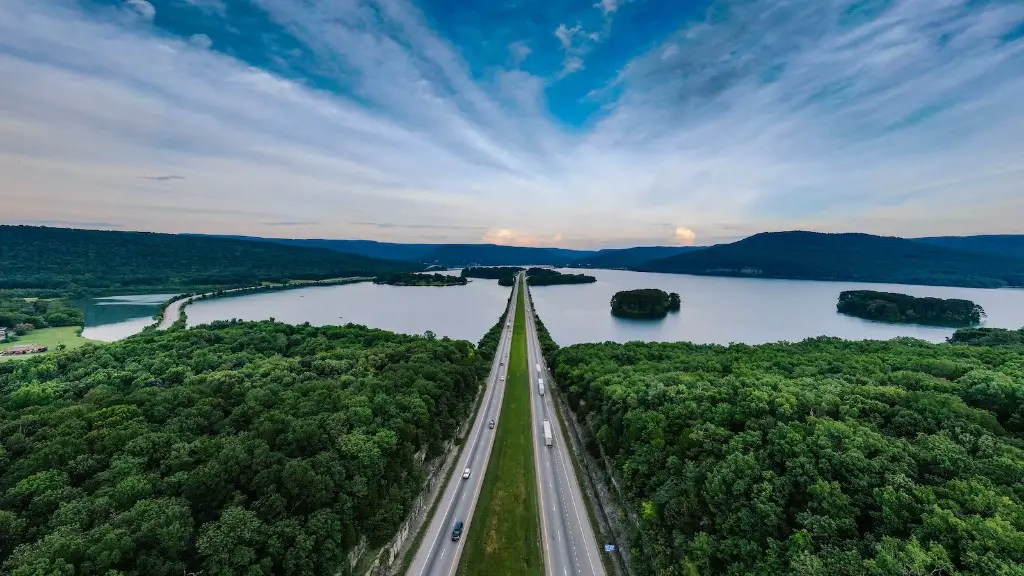The Mississippi River is one of the most important waterways in the United States, and it has always played an essential role in the nation’s economic, social, and cultural development. Since it is so vital and valuable, keeping the river clean, navigable, and usable has always been an important part of its maintenance. This is why the dredging of the Mississippi River is so important. Dredging is the process of excavating and removing sediment from a river bottom or lake in order to deepen or maintain navigable waterways.
Dredging has been a part of maintaining and managing the Mississippi River since the early 19th century. It had become evident to observation that the buildup of silt from the natural sediment that had been tumbling down the river was beginning to impede commerce and navigation. The problem of this accumulating sediment needed to be addressed, and the only solution at the time was to dredge or dig it out.
In 1824, the US Congress authorized the use of federal money to dredge the river. This allowed for the creation of a 6-foot deep navigational channel that ran all the way from the Mississippi Delta to St. Louis. The US Army Corps of Engineers was put in charge of the task and they prevailed over the project for the entirety of the century. As the channel size and the ability to carry heavier boats grew, so did the improvement of ports, harbors and marinas along the way.
Dredging allowed for even larger ships to traverse the Mississippi River and for a more efficient transportation of freight as well as more opportunities for commerce. By the year 1876, the dredging of the Mississippi River was complete and the channel depth had increased to 9 feet. This newfound depth permitted a vast variety of goods to be shipped up and down the river including: cotton, timber, corn, coal, petroleum products, agricultural goods, and cement.
Unfortunately, dredging is not a one-time solution and it must be regularly maintained in order to keep its navigability. The sediment from the upper reaches of the river continues to drift down and deposit in the deeper portions, causing the river to fill in and the navigation channel to become shallower. As a result the U.S. Army Corps of Engineers has the on-going responsibility to monitor and periodically dredge the Mississippi River.
Currently the Corps of Engineers uses a variety of different methods for dredging such as hydraulic dredges, mechanical dredges, suction hoppers, and other specialized pieces of equipment. They also utilize high-tech sensing systems, such as multi-spectral and scanning sonar, to detect and identify the most efficient and cost-effective methods for dredging or placing sediment.
Impacts of dredging the Mississippi River
Dredging the Mississippi River has had a number of positive impacts on the environment and on commerce and transportation in the region. The deeper navigational channel provides a much safer and more reliable route for boats and industry to traverse. The increased depth also reduces the amount of friction between boats and the river bottom, making it easier for them to move through the water.
Dredging also helps to maintain the health of the Mississippi River. The sediments and other pollutants that can accumulate on the bottom of the river can be extremely harmful to fish, plants, and other organisms. By routinely dredging the river, these pollutants are removed and the river is kept clean and safe for its inhabitants.
Dredging can also help to prevent flooding by keeping the river full and allowing an easier path for flood waters to be carried away. When the river is not deep enough, the water does not move as quickly and can back up, causing flooding. Dredging helps to prevent this by deepening the river and creating a faster and stronger water flow.
The dredging of the Mississippi River has also had economic benefits. It has helped to create jobs, both directly through the dredging process and indirectly, through the economic activity that is generated as a result of the river’s improved navigability.
Environmental Impacts
While dredging has many benefits, it also has a number of potential environmental consequences that should be taken into consideration. To start, the dredging process itself can stir up sediment and pollutants that were deposited in the river and release them into the surrounding environment. This can be damaging to the organisms that inhabit the river.
For this reason, great care must be taken to limit the amount of sediment and pollutants that are released during the dredging process. The way this is done is by using specific types of dredging equipment and techniques that are designed to minimize the impact on the environment.
Another environmental effect of dredging is to the habitats and ecosystems of the area. Dredging can destroy the natural features of the river, as well as cause disruption to the flora and fauna that live in it. To help reduce these impacts, dredging activities are typically done at the right time of year and in the right season, when it is less likely to disrupt the normal life cycles of these organisms.
Finally, one of the most important environmental concerns related to dredging is the effect it can have on the water quality of the river. The added sediment and pollutants can contaminate the water, which can have a serious impact on the local ecology and aquatic life. Again, the Corps of Engineers takes many steps to prevent this from happening, such as using the latest technologies and techniques to reduce sediment and pollutant runoff.
Cost of Dredging Mississippi River
The cost of dredging the Mississippi River can vary depending on the type of dredging being done and how much dredging is needed. Generally, however, the cost is quite high. Depending on the project, the cost of dredging can range from hundreds of thousands of dollars to millions of dollars. The costs can include the dredging itself, as well as any monitoring or permitting that is needed as part of the process.
These costs are typically shared between the federal government and the local area in which the dredging is being done. For example, if the dredging is being done on the Mississippi River, then the federal government and the local authorities of the surrounding states may both contribute financially.
In addition to the costs of dredging itself, there are also costs associated with disposing of the dredged sediment. Depending on how the dredging project is managed, the sediment may be disposed of in a variety of ways, from being placed in containment areas to being removed and disposed of offsite.
These disposal costs are typically factored into the overall cost of a dredging project and can increase the price significantly. It is also important to note that when dredging a river, there are typically multiple stages of work involved, which can also affect the overall cost.
Conclusion
The dredging of the Mississippi River is an essential part of maintaining navigability and verifying its value to the surrounding areas. It has been a part of the river’s management since the 18th century and the Corps of Engineers has been the major authority over the process from the beginning. Dredging has had a number of positive impacts on both the environment and commerce, but it also has potential environmental consequences that must be considered as well.
Legislation for Dredging
In order to ensure that the process of dredging the Mississippi River is managed correctly, there are a number of laws and regulations in place. The US Army Corps of Engineers is required to submit a detailed plan for all dredging projects, outlining the process and providing a timeline for when it will occur. This plan must be approved by the federal government before any work can begin.
The regulations also outline the types of dredging that are allowed, as well as what type of sediment and pollutants are allowed to be dredged and where they may be disposed of. Furthermore, they also regulate the type and size of vessel that can be used for the dredging operation.
The majority of these rules and regulations are enforced by the US Environmental Protection Agency, as well as the US Coast Guard and the US Navy. Numerous state and local authorities also have their own regulations that must be followed when dredging a river.
Benefits of Dredging for the Mississippi River
The dredging of the Mississippi River has a number of important benefits. It helps to maintain navigability, improve port infrastructure, and prevent flooding in the region. It also helps to keep the river clean and free of pollutants, which helps to protect the local ecology and aquatic life.
It can also have an economic benefit by generating jobs and providing opportunities for commerce. Finally, it is important to remember that the cost of dredging can be expensive but the benefits of doing so outweigh the costs in the long run.
Challenges for Mississippi River Dredging
Despite the numerous benefits of dredging the Mississippi River, there are also a number of challenges as well. One of the biggest challenges is managing the dredging process in a way that minimizes the environmental impacts. It is also important to make sure that the sediment and pollutants unearthed during the process are disposed of properly.
In addition, the cost of dredging can be a strain on local and federal budgets, especially for larger and more complex projects. Finally, because the river continues to build up sediment, the process of dredging must be continually monitored and maintained in order to keep the navigation channel deep and usable.
Conclusion
It is evident that dredging the Mississippi River is an important part of its maintenance and has been since the 19th century. While there are many benefits to this process, there are also a number of challenges. It is essential that all of these factors are considered when managing this process in order to ensure that it is done in a safe and responsible manner.





